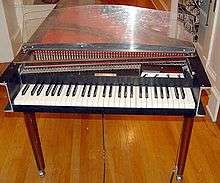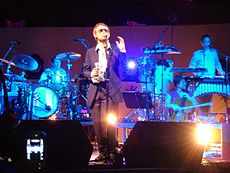Baroque pop
Baroque pop (sometimes called baroque rock) is a fusion genre that combines rock music with particular elements of classical music.[4][2][3] It emerged in the mid 1960s as artists pursued a majestic, orchestral sound[2] and is identifiable for its appropriation of Baroque compositional styles (contrapuntal melodies and functional harmony patterns) and dramatic or melancholic gestures.[1] Harpsichords figure prominently,[5][3] while oboes, French horns, and string quartets are also common.[3]
| Baroque pop | |
|---|---|
 | |
| Other names | Baroque rock |
| Stylistic origins | |
| Cultural origins | 1960s, United States and United Kingdom |
| Typical instruments | |
| Derivative forms | |
| Other topics | |
Although harpsichords had been deployed for a number of pop hits since the 1940s, starting in the 1960s, some record producers increasingly placed the instrument in the foreground of their arrangements.[5] Inspired partly by the Beatles' song "In My Life" (1965), various groups were incorporating baroque and classical instrumentation by early 1966.[6] The term "baroque rock" was coined in promotional material for the Left Banke, who used harpsichords and violins in their arrangements[7] and whose 1966 song "Walk Away Renée" exemplified the style.[5][8]
Baroque pop's mainstream popularity faded by the 1970s, partially because punk rock, disco and hard rock took over; nonetheless, music was still produced within the genre's tradition.[8] Philadelphia soul in the 1970s and chamber pop in the 1990s both incorporated the spirit of baroque pop[2] while the latter contested much of the time's low fidelity musical aesthetic.[9]
Characteristics
In classical music, the term "Baroque" is used to describe the art music of Europe approximately between the years 1600 and 1750, with some of its most prominent composers including J. S. Bach and Antonio Vivaldi.[10] Much of the instrumentation of baroque pop is akin to that of the late Baroque period or the early Classical period, chronologically defined as the period of European music from 1690 to 1760 and stylistically defined by balanced phrases, clarity and beauty,[11] using string sections, woodwinds and brass instruments.
Baroque pop, stylistically, fuses elements of rock with classical music, often incorporating layered harmonies, strings, and horns to achieve a majestic, orchestral sound.[2] Its prominent characteristics are the use of contrapuntal melodies and functional harmony patterns.[1] It was intended to be a more serious and mature outgrowth of rock music.[2] "English baroque" is used by journalist Bob Stanley to describe a subset that existed between 1968 and 1973.[8][nb 1] "Baroque rock" may be invoked as a synonym of "baroque pop"[13] or as its own distinct term.[14]
History
Precursors (early 1960s)
Starting in the 1960s, pop musicians and record producers like Phil Spector and the Beach Boys' Brian Wilson began placing the harpsichord in the foreground of their arrangements.[5] Harpsichords were widely available in recording studios, and had been used in popular music since as early as the 1940s, but it would not gain prominence until the 1960s.[5] One of the first pop rock hits to use a harpsichord was the Jamies' "Summertime, Summertime" (1958).[15] Later examples range from the Beach Boys' "I Get Around" (1964) and "When I Grow Up (To Be a Man)" (1965) to the Righteous Brothers "You've Lost That Lovin' Feelin'" (1964) and the Mamas & the Papas' "Monday, Monday" (1966).[5] The Boston Globe's Matthew Guerrieri speculates that the harpsichord may have been desirable for its buzzing, stinging timbre, which suited "the treble-heavy pop soundscape" of the time.[5][nb 2]
Slate's Forrest Wickman credits Wilson and the Beatles' producer, George Martin, as some of the men "most responsible" for the move into baroque pop.[16] Along with Burt Bacharach, Spector had melded pop music with classical elements before they were melded with rock.[4] Writer Andrew Jackson suggests that "the era of baroque pop" in which "rock melded with classical elements" was prefaced by the Rolling Stones ("Play with Fire", February 1965) and Brian Wilson (The Beach Boys Today!, March 1965).[4] Author Bob Gendron argues that, rather than assuming that the Beatles themselves instigated the link between their music and its classical components, it is more plausible that they were responding to various classical and baroque readings of their work, such as the 1965 album The Baroque Beatles Book, which reimagines their songs in a tongue-in-cheek Baroque setting.[17]
The Beatles benefited from the classical music skills of Martin, who played what sounded like a baroque harpsichord solo on the song "In My Life", released on their December 1965 album Rubber Soul.[18] (The instrument used was actually a piano recorded on tape at half speed and then sped up.[15]) Author Joe Harrington noted that after its release, many "baroque-rock" works would soon appear.[18] Producer Tommy LiPuma believed: "Once the Beatles featured that harpsichord sound on 'In My Life,' pop producers began working it in."[15]
Emergence (mid to late 1960s)

The genre is traced to the United States and the United Kingdom.[1] By early 1966, various groups began using baroque and classical instrumentation, described as a "baroque rock" movement by Gendron.[19] The Zombies' single "She's Not There" (1964) marked a starting point for British baroque pop. Stanley explains that the song "didn't feature any oboes but stuck out rather dramatically in 1964, the year of 'You Really Got Me' and 'Little Red Rooster'".[8] "She's Not There" would inspire New York musician Michael Brown to form the Left Banke, whose song "Walk Away Renée" (1966) is considered by Stanley to be the first recognizable baroque pop single.[8] "Baroque rock" was the label devised by the band's publicists and the music press. According to Richie Unterberger, "the sobriquet may have been ham-fisted, but certainly there were many Baroque elements in the Left Banke's pop—the stately arrangements, the brilliant use of keyboards and harpsichords, the soaring violins, and the beautiful group harmonies."[7] Guerriri says that, in Britain, the song "bridged the passage from rock into psychedelica for numerous groups: the Beatles, the Rolling Stones, the Zombies, [and] the Kinks."[5]
Conversely, Decider wrote that the Beach Boys' album Pet Sounds (May 1966) "almost single-handedly created the idea of 'baroque pop.'"[20] The only track on the album that employs a harpsichord in conjunction with a string section is "God Only Knows".[21][nb 3] The Sydney Morning Herald deemed the song a particularly "exquisite" example of baroque pop,[22] whereas The Record's Jim Beckerman called it "baroque rock" in the same "retro instrumentation and elegant harmonies" vein as the Beatles' "Eleanor Rigby" (August 1966) and Procol Harum's "A Whiter Shade of Pale" (1967).[23] Gendron's "baroque rock" examples include "Walk Away Renée" with Spanky and Our Gang's "Sunday Will Never Be the Same" (1967), and the Stone Poneys' "Different Drum" (1967) – all of which used harpsichord and strings.[24][nb 4]
Stanley highlighted a strand of baroque pop he calls "English baroque", it being a combined simulacrum of the Zombies' album Odessey and Oracle (1968), Paul McCartney's contributions to The White Album (1968), Honeybus' single "I Can't Let Maggie Go" (1968), Scott Walker's chamber pop, and Crosby, Stills & Nash vocal harmonies.[8][nb 5]
Dissipation and revival (1970s–present)

The "quaintness" of baroque pop and the use of violins and classical guitar became the target of parody at the end of the psychedelic era.[25] In the 1990s, chamber pop would derive from the "spirit" of baroque pop, characterized by an infusion of orchestral arrangements or classical style composition. It originated as a response to the lo-fi production that dominated in the 1990s.[9] Between the 1990s and 2010s, baroque pop has enjoyed a revival with bands like the Divine Comedy[1] and Panic! at the Disco.[26]
Footnotes
- A compilation, Tea & Symphony: The English Baroque Sound 1967–1974 (2007), features music that reviewer Stephen Thomas Erlewine says is mostly inspired by Paul McCartney, the Zombies and Gilbert O'Sullivan.[12]
- In the 1960s, most recordings were monaural, and AM radio was the dominant form of musical consumption.[5]
- Of the album's 12 tracks, only two more feature a harpsichord: "You Still Believe in Me" and "Caroline, No".[21]
- Further listed are the Rolling Stones' "Lady Jane" (1966, harpsichord and dulcimer) and the Lovin' Spoonful's "Rain on the Roof" (1967, harpsichord-sounding guitars).[24]
- Stanley believes that this "lost corner of pop history" climaxed with the Beatles' 1967 album Sgt. Pepper's Lonely Hearts Club Band, "which mixed everyday lyrics with music hall and Edwardiana to create lysergically enhanced parlour music". One year later, he writes, the "predominant trend was to get hairier, heavier, more long-winded". English baroque survived for the next few years, during when record labels sought to capitalize on the nascent singer-songwriter movement by offering lavish string arrangements to unknowns; Nick Drake was one such beneficiary.[8]
References
- Hawkins 2015, p. 193.
- "Baroque pop". AllMusic.
- Smith, Steve (November 29, 2012). "Steve Smith: Wyman and Taylor join the Rolling Stones onstage; Coldplay takes a break". Pasadena Star-News. Archived from the original on December 3, 2012.
- Jackson 2015, p. 22.
- Guerrieri, Matthew (January 22, 2016). "Via Spector and serendipity, the harpsichord invaded pop". The Boston Globe.
- Gendron 2002, pp. 174, 343, various groups using baroque instrumentation in early 1966; Harrington 2002, p. 191, baroque rock inspired by "In My Life"
- Unterberger 2014, p. 416.
- Stanley, Bob (September 21, 2007). "Baroque and a soft place". The Guardian.
- "Chamber pop". AllMusic.
- Essentials of music: Baroque composers Archived 2008-12-19 at the Wayback Machine.
- Oxford Music Online 2
- Erlewine, Stephen Thomas. "Tea & Symphony: The English Baroque Sound 1967-1974". AllMusic.
- Perný 2014, p. 37.
- Saas, Don (May 14, 2015). "The Baroque Rock Of The Spring Standards". Baeble Music.
- Myers, Marc (October 30, 2013). "Bach & Roll: How the Unsexy Harpsichord Got Hip". The Wall Street Journal.
- Wickman, Forrest (March 9, 2016). "George Martin, the Beatles Producer and "Fifth Beatle," Is Dead at 90". Slate.
- Gendron 2002, p. 173.
- Harrington 2002, p. 191.
- Gendron 2002, pp. 174, 343.
- Smith, Benjamin H. "The Album May Be Dead, But The Beach Boys' Classic 'Pet Sounds' Lives On In New Documentary". Decider. Retrieved 20 April 2017.
- Boyd, Alan; Slowinski, Craig (2016). "Pet Sounds Sessionography". Pet Sounds (CD Liner). The Beach Boys. Capitol Records.
- Valentish, Jenny (December 5, 2015). "Pet Sounds acknowledged as a masterpiece, as Brian Wilson brings it to Australia". The Sydney Morning Herald.
- Beckerman, Jim (March 21, 2015). "'Walk Away Renee' collaborator Michael Brown of Englewood Cliffs, dies at 65". The Record.
- Gendron 2002, p. 343.
- White 2015, p. 190.
- Album Review: Too Weird to Live, Too Rare to Die! by Panic! At The Disco. studlife.com. Retrieved May 4, 2015.
Bibliography
- Gendron, Bernard (2002). Between Montmartre and the Mudd Club: Popular Music and the Avant-Garde. University of Chicago Press. ISBN 978-0-226-28737-9.CS1 maint: ref=harv (link)
- Harrington, Joe S. (2002). Sonic Cool: The Life & Death of Rock 'n' Roll. Hal Leonard Corporation. ISBN 978-0-634-02861-8.CS1 maint: ref=harv (link)
- Hawkins, Stan (2015). Queerness in Pop Music: Aesthetics, Gender Norms, and Temporality. Routledge. ISBN 978-1-317-58972-3.CS1 maint: ref=harv (link)
- Jackson, Andrew Grant (2015). 1965: The Most Revolutionary Year in Music. Thomas Dunne Books. ISBN 978-1-250-05962-8.CS1 maint: ref=harv (link)
- Perný, Lukáš (2014). Music Counterculture at the Break of 1960s and 1970s in the Culturological Perspective (in Slovak). Univerzita Konštantína Filozofa v Nitre, Filozofická fakulta, Katedra kulturológie. ISBN 978-80-558-0677-8.CS1 maint: ref=harv (link)
- Unterberger, Richie (2014). Urban Spacemen & Wayfaring Strangers: Overlooked Innovators & Eccentric Visionaries of '60s Rock. BookBaby. ISBN 978-0-9915892-4-1.CS1 maint: ref=harv (link)
- White, Michael (2015). Popkiss: The Life and Afterlife of Sarah Records. Bloomsbury Publishing. ISBN 978-1-62892-220-2.CS1 maint: ref=harv (link)
